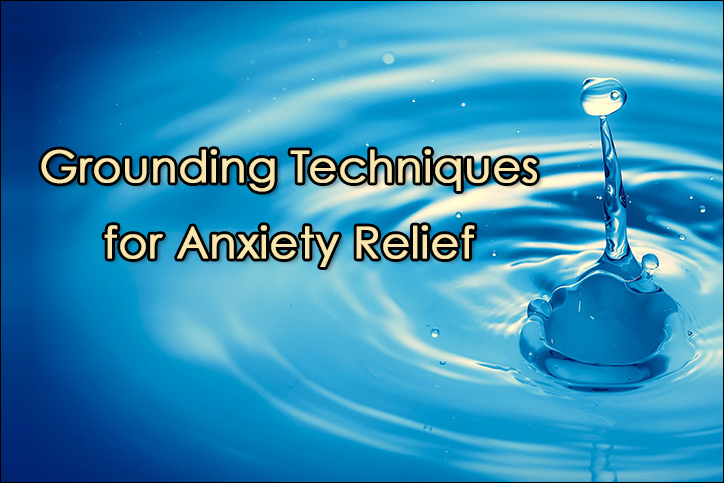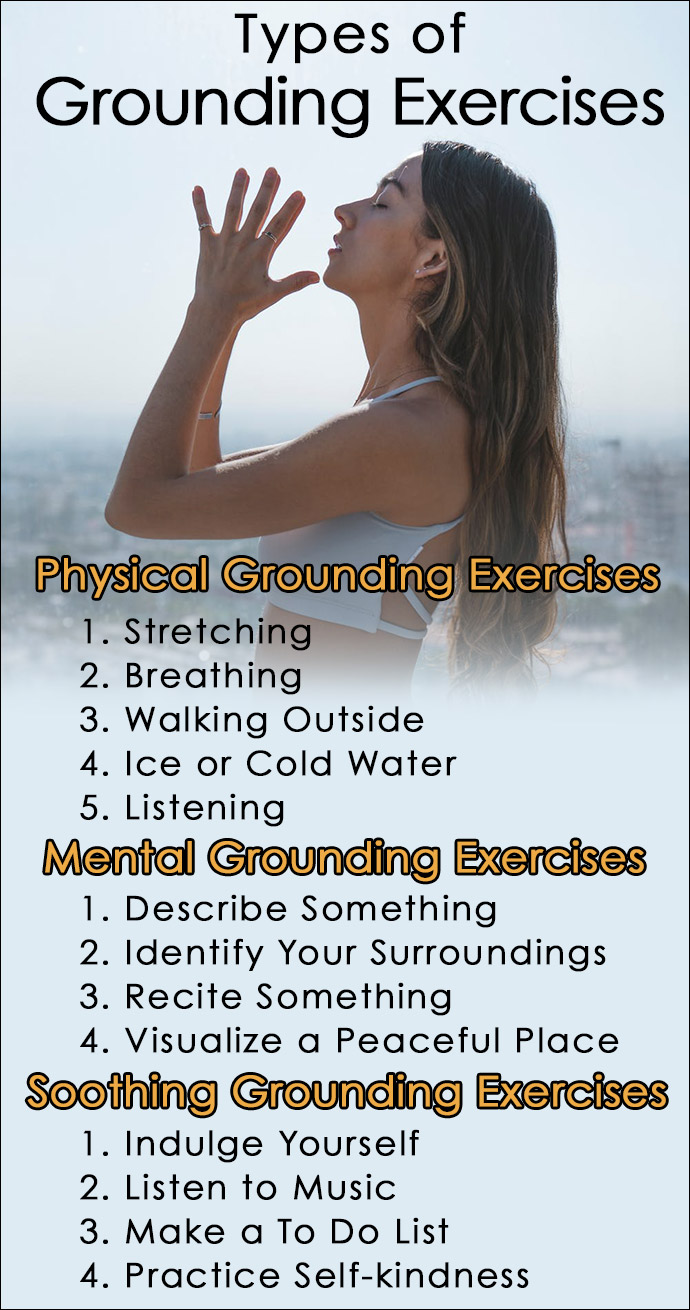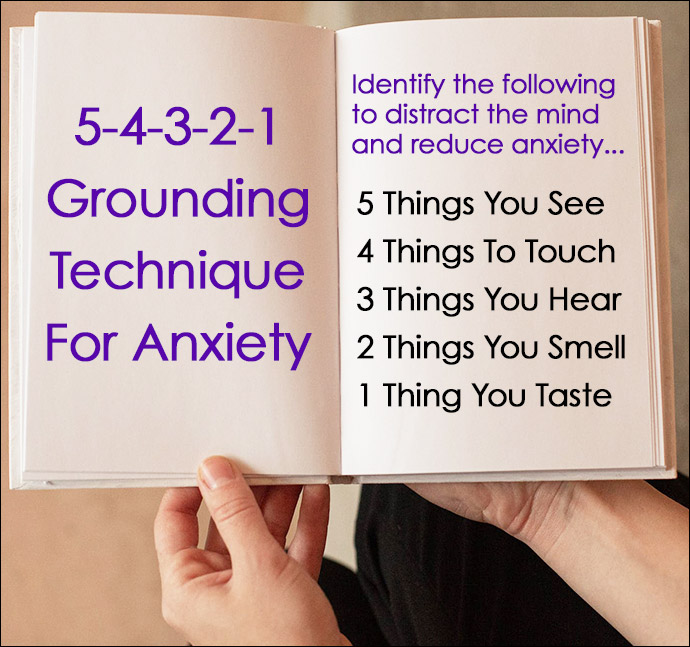Table of Contents
Learning how to use grounding techniques for anxiety, like the 54321 grounding exercise, are excellent ways to interrupt a cycle of stress or worry and quickly promote a sense of calm.
Most people are familiar with the symptoms of a mild anxiety attack, when a sudden nervousness or fear takes over and makes it difficult to focus on the task at hand.
A severe attack of anxiety, on the other hand, can be crippling. Severe anxiety can cause physical or emotional symptoms that negatively influence a person’s mental health.
Grounding techniques for anxiety are incredibly helpful tools to minimize the impact of challenging bouts of fear, stress, and worry.
What are Grounding Techniques for Anxiety?
For anyone that regularly experiences anxiety, it’s important to know that you’re not alone, and simple grounding techniques are helpful for managing the symptoms.
There are different types of anxiety and these highly treatable disorders are the most common form of mental illness in the United States, affecting nearly 40 million adults every year.
Unfortunately, less than 40% of people who suffer from these common conditions ever receive treatment, according to the Anxiety & Depression Association of America.
Simply put, grounding techniques for anxiety are tools or exercises that involve using a person’s five senses to re-focus and distract from feelings of anxiousness.
Grounding exercises can help diminish the effect of stressful situations and feelings related to any number of conditions.
Grounding Techniques are Effective for These Conditions:
- Post-traumatic Stress Disorder (PTSD)
- Anxiety
- Depression
- Chronic Stress
- Low Self-esteem
- Mood Swings
Whatever the issue may be, when a mild annoyance or an overwhelming sense of doom arises, grounding techniques can help calm the mind.
They also allow us time to respond in a positive manner instead of reacting negatively.
Benefits of Grounding Techniques
Grounding techniques and exercises are beneficial tools to anchor us in the present moment during stressful situations.
Feelings of anxiety often stem from completely normal life situations, like a big job interview or an impending mid-term exam.
Other times they are connected to a more serious issue, such as depression or early childhood trauma.
Deploying grounding exercises will lessen some of the physical and emotional symptoms of anxiety without the side effects of anxiety medication.
They also help us think more clearly, make healthier decisions, and approach our anxiety from the standpoint of productive problem solving.
It doesn’t take an expert in psychology to learn effective grounding techniques for anxiety. They are easy to do and become familiar with, even in the beginning.
Grounding exercises are sometimes divided into three categories as physical, mental, and soothing grounding techniques.
One of the most effective is the 54321 Grounding Technique, and it deserves a category of its own.
Physical Grounding Techniques
The physical symptoms of anxiety, like sweaty palms, tremors, or a rapid heart rate often get away from us and increase the feelings of fear and anxiousness.
Physical grounding techniques are helpful for easing the physical symptoms of anxiety.
Physical Grounding Technique Examples
1. Stretching
Take a moment to stretch out your arms and legs, focusing on your entire body from the tips of your toes to the tips of your fingers. While extending your arms upward, reach high for the ceiling.
When you bring your arms down, gently rotate the head and neck around, taking time to make sure your back is straight.
2. Breathing
Focusing on your breath as it enters and exits your body is an excellent way to slow down racing thoughts or a fast beating heart.
This can be done while employing the stretching technique or by sitting quietly in a chair and taking several minutes to regulate your breathing. Pay attention to how your breath feels, and notice that it’s cool as you inhale and warm as you exhale.
3. Walking Outside
Take a walk outdoors for at least 5 to 10 minutes. While walking, feel the sun and wind on the face and body. Paying attention to how the body feels while walking can lessen the symptoms of anxiety.
4. Ice or Cold Water
Hold a piece of ice in your hands, or put them under cold running water whenever you feel anxious. Notice the change in temperature of the water on your hands, or watch how long it takes for the piece of ice to melt into a puddle of water in your palm.
Completely focusing on the physical feelings and changes will distract the mind from being anxious.
5. Listening
Take a moment to fully listen to your surroundings. What do you hear? Maybe there are birds chirping or dogs barking. There might be the sound of traffic in the distance or people having a conversation in the next office.
As the sounds combine, try to hear all of them at once while identifying each one.
Mental Grounding Exercises for Anxiety
Mental grounding exercises are intended to redirect our thoughts away from distressing feelings and emotions to provide a sense of calm in the mind.
Examples of Mental Grounding Exercises
1. Describe Something
In detail, describe a simple activity you’re familiar with, like taking a shower.
“First, I open the shower door and turn on the hot water, so it can heat up. Then, I make sure there’s a clean towel within reach before I slip my clothes off. Finally, I turn up the cold water so it’s not too hot and step into the shower.”
2. Identify Your Surroundings
Take a moment to look at your surroundings. Again, in detail, mentally identify to yourself or out loud every single thing in the room, from the number of chairs to the color of the walls. Perhaps the ceiling is textured or tiled.
What color are the walls? Is the floor wood or carpeted? What color is it? Maybe the room has a distinct smell. Don’t stop taking an inventory of the room until you have identified everything you can about it.
3. Recite Something
Recite something you have memorized. This might be a brand new song you sing while in the car or maybe it’s a poem or old saying that has always stuck with you. It can be anything. Say it out loud and focus on each word and what they all mean together.
4. Visualize a Peaceful Place
Visualize a peaceful place where painful feelings or problems can’t reach you. This could be a mountaintop, the beach, or anywhere you find enjoyable. Imagine what the wind and sun feels like on your skin.
Is it cool at the top of the mountain? Are there clouds settled in the sky with rays of sun piercing through them? Be specific and include plenty of details while visualizing a place that makes you happy.
Soothing Grounding Techniques
It’s quite common during feelings of anxiety to have negative thoughts or unhealthy patterns of self-talk. Soothing grounding techniques focus on changing those patterns to kinder and more loving self-talk and thinking.
Examples of Soothing Grounding Techniques
1. Indulge Yourself
Take yourself out for something you enjoy. Perhaps an hour-long massage, a nice meal, or a film you want to see are on your to do list. Maybe it’s a warm bath or reading a good book in a peaceful setting.
Make the point of telling yourself that you deserve this treat and set aside some “me time” to enjoy yourself.
2. Listen to Music
Maybe there’s a new album you want to listen to in its entirety, or perhaps you enjoy creating a new playlist of songs you love.
Simply listening to music, while relaxing in a peaceful setting, taking a walk, or even in the car can take us to another place and ease anxious thoughts and feelings.
3. Make a To Do List
Make a To Do List of positive things in your life that bring you joy. Then make a plan to interact with the things on your list within the coming week, if at all possible.
The items on the list don’t have to be extravagant travel experiences. They could be as simple as having ice cream with a friend or spending time with a loved one.
4. Practice Self-kindness
Whenever feelings of anxiety try to get the best of us, take a moment to tell yourself you’ll get through these challenges like you always have in the past.
Remind yourself you are strong enough to handle the problem, and you are doing everything in your power to put these issues behind you.
54321 Grounding Technique
The 54321 Grounding Technique is a simple and effective way of incorporating many of the approaches mentioned above into one useful exercise that can be performed almost anywhere.
At its most basic level, the 54321 Grounding Technique combines mindfulness with the five senses to overcome anxious thoughts and feelings.
By intentionally directing your attention to the five senses, it interrupts a negative cycle of worry or anxiety to inspire a calm and relaxed mind.
How Does the 54321 Grounding Technique Work?
This exercise is sometimes called the “5 Senses Grounding Technique” because it engages all five senses:
- Seeing
- Hearing
- Touching
- Smelling
- Tasting
Using all five senses distracts the mind from stressful thoughts and anchors it in the present moment to minimize the effects of a stress response.
This activates the parasympathetic nervous system (PNS) to promote a sense of relaxation, and lessens symptoms of a rapid heartbeat, difficulty breathing, and panic attacks.
Implementing the 54321 Grounding Technique
Follow these five steps any time you are overwhelmed by stress or anxiety.
1. Identify 5 Things You Can See
Name out loud, 5 things you can see anywhere around you.
2. Touch 4 Things
Find 4 things you can touch, and while doing it, pay attention to the way each one feels.
3. Listen for 3 Things You Can Hear
Next, focus on 3 things you can hear. It can be something near you inside, or a distant sound outside, like birds chirping or traffic.
4. Find 2 Things You Can Smell
Don’t simply grab two things nearby that are within reach, but instead, take it a step further and find two things with a pleasurable aroma, like a scented candle in the next room or flowers outside in the garden.
5. Describe 1 Thing You Can Taste
Focus your attention on one thing you can taste. This could be a piece of gum in your mouth or a cup of coffee on your desk.
Performing all the steps of the 54321 Grounding Technique is beneficial for quickly overcoming the mental and physical effects of anxiety and improving mood and well-being.
All of these grounding techniques for anxiety are helpful ways to anchor the mind and disrupt an unhealthy cycle of worry and stress. They can even be practiced on a regular basis to promote a calm mind before anxiety occurs.





